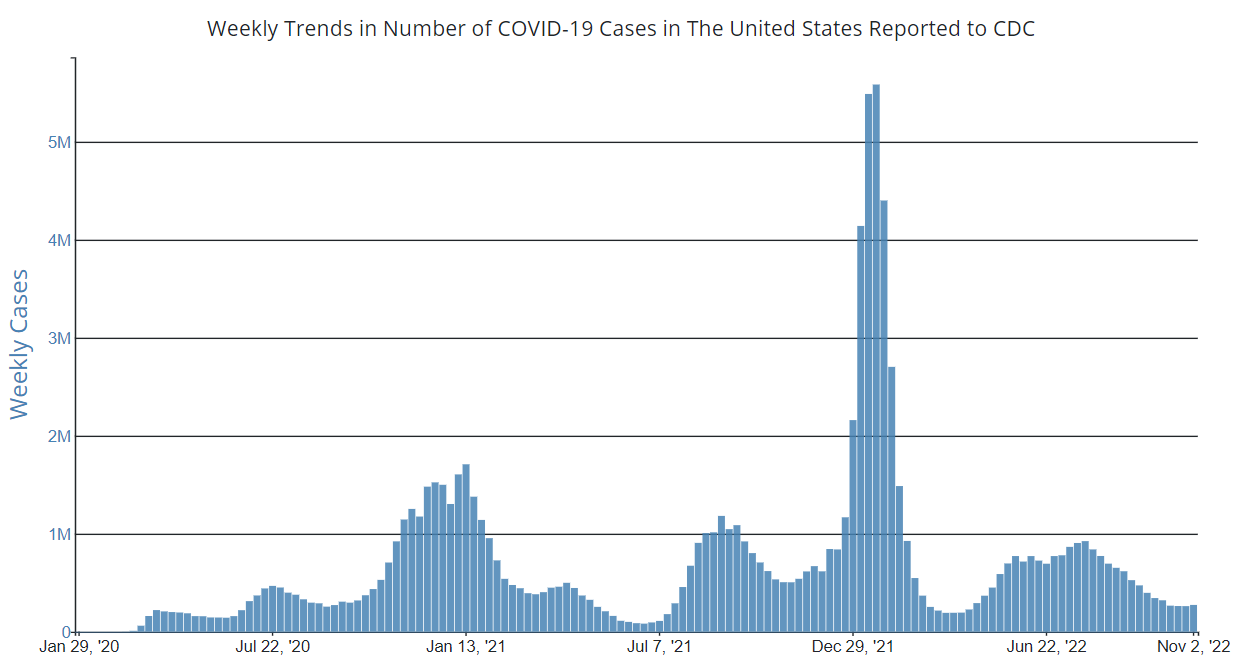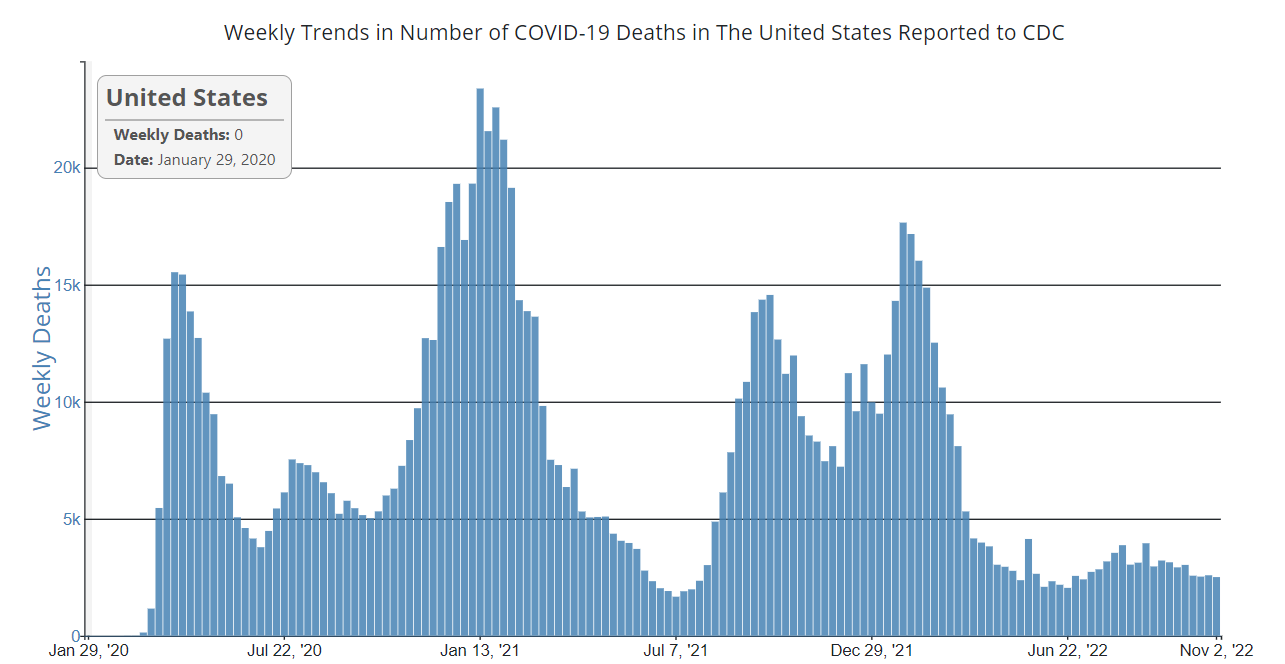Recommendations for Fully Vaccinated People
COVID-19 Homepage
Stay Safe this Season
Interpretive Summary for November 4, 2022
Stay Safe this Season
COVID-19 cases and hospitalizations in the United States have been decreasing for the past few months, but that decline has slowed in recent weeks. Meanwhile, cold and flu season is off to an earlier start than usual, with respiratory viruses like flu and respiratory syncytial virus (RSV) on the rise, especially among children. The combination of COVID-19, flu, and RSV could continue to stress the healthcare system this fall and winter.
COVID-19 vaccinations and treatments are the best protection against serious illness from COVID-19, but uptake of the new bivalent booster has been low since CDC recommended it in September. More than 26 million people over age 5 years have gotten an updated booster, but that’s only 8.4% of the U.S. population. Hundreds of millions more people need to get up to date with their COVID-19 vaccinations.
As people start to travel and gather for the holidays, it’s vitally important that we protect ourselves and others from COVID-19 and all respiratory viruses. You can do this through masking, testing, and other layered prevention measures such as improving ventilation and spending time outdoors. You can also use COVID-19 Community Levels to help you make an informed decision about what steps to take. Children ages 6 months to 4 years should get a flu shot and complete their COVID-19 primary series. Everyone ages 5 years and older should get a flu shot and an updated booster. You can get a flu shot and a booster at the same time if you want. Check if and when to get COVID-19 boosters with CDC’s COVID-19 booster tool.
- The Vaccination Demographic Trends page was updated to display national trends in bivalent booster dose receipt by age, sex, and race and ethnicity.
COVID-19 Community Levels*
As of November 3, 2022, there are 78 (2.0%) counties, districts, or territories with a high COVID-19 Community Level, 614 (20.1%) counties with a medium Community Level, and 2,525 (77.5%) counties with a low Community Level. Compared with last week, this represents a minor increase (+0.2 percentage points) in the number of high-level counties, a minor decrease (-2.8 percentage points) in the number of medium-level counties, and a minor increase (+2.7 percentage points) in the number of low-level counties. Overall, 45 out of 52 jurisdictions** had high- or medium-level counties this week. California, Delaware, the District of Columbia, Hawaii, Rhode Island, South Carolina, and Washington are the only jurisdictions to have all counties at low Community Levels.
To check your COVID-19 Community Level, visit COVID Data Tracker. To learn which prevention measures are recommended based on your COVID-19 Community Level, visit COVID-19 Community Level and COVID-19 Prevention.
*CDC recommends use of COVID-19 Community Levels to determine the impact of COVID-19 on communities and to take action. CDC also provides Community Transmission Levels to describe the amount of COVID-19 spread within each county. Healthcare facilities use Community Transmission Levels to determine infection control interventions.
**Includes the 50 states, the District of Columbia, and Puerto Rico.
Reported Cases
As of November 2, 2022, the current 7-day average of weekly new cases (39,016) increased 4.7% compared with the previous 7-day average (37,261). A total of 97,604,763 COVID-19 cases have been reported in the United States as of November 2, 2022.
Variant Proportions
CDC Nowcast projections* for the week ending November 5, 2022, estimate that the combined national proportion of lineages designated as Omicron will continue to be 100%. There are eight lineages designated as Omicron with estimates above 1%: BA.5—and four of its sublineages (BQ.1, BQ.1.1, BF.7, and BA.5.2.6)—BA.4.6, BA.2.75, and BA.2.75.2. The predominant Omicron lineage is BA.5, projected to be 39.2% (95% PI 36.2-42.3%).
The national proportion of BQ.1.1 is projected to be 18.8% (95% PI 15.7-22.4%), BQ.1 is projected to be 16.5% (95% PI 13.6-20.0%), BA.4.6 is projected to be 9.5% (95% PI 8.6-10.5%), BF.7 is projected to be 9.0% (95% PI 7.9-10.1%), BA.5.2.6 is projected to be 3.1% (95% PI 2.5-3.7%), BA.2.75 is projected to be 2.3% (95% PI 1.9-2.8%), and BA.2.75.2 is projected to be 1.3% (95% PI 0.9-1.7%). See COVID Data Tracker for current data.
97,604,763
Total Cases Reported
39,016
Current 7-Day Average**
37,261
Previous 7-Day Average
4.7%
Change in 7-Day Average since Previous Period
*CDC uses Nowcast projections to predict current variant proportions circulating in the United States. The median time from specimen collection to sequence data reporting is about 3 weeks. As a result, weighted estimates for the most recent few weeks may be unstable or unavailable. View Nowcast estimates on CDC’s COVID Data Tracker website on the Variant Proportions page.
**Historical cases are excluded from weekly new cases and 7-day average calculations until they are incorporated into the dataset for the applicable date. No historical cases reported at this time.
Vaccinations
COVID-19 Vaccine Primary Series
As of November 2, 2022, 640.9 million vaccine doses have been administered in the United States. Overall, about 266.4 million people, or 80.2% of the total U.S. population, have received at least one dose of vaccine. About 227.4 million people, or 68.5% of the total U.S. population, have completed a primary series.*
640,913,400
Vaccine Doses Administered
266,401,911
People who received at least one dose (80.2% of the U.S. population)
227,377,753
People who have completed a primary series* (68.5% of the U.S. population)
+0.1
Percentage point change from last week
+0.1%
Percentage point change from last week
*Represents the number of people who have received the second dose in a two-dose COVID-19 vaccine series (such as the Pfizer-BioNTech, Moderna, or Novavax vaccines) or one dose of the single-shot Johnson & Johnson’s Janssen vaccine.
COVID-19 Vaccine Boosters
Of those who have completed a primary series, about 112.5 million people have received a booster dose,* and more than 26.38 million people have received an updated (bivalent) booster dose. But 49.1% of the total booster-eligible population has not yet received a booster dose. Booster dose eligibility varies by age and health condition. Learn more about who is eligible.
147,242,201
Booster Doses Administered
112,473,353
Population ≥ 5 Years of Age with a 1st booster dose*
28,830,116
Population ≥ 50 Years of Age with a 2nd booster dose**
49.6%
Percentage of the Population ≥ 5 Years of Age with a 1st booster dose
43.2%
Percentage of the Population ≥ 50 Years of Age with a 2nd booster dose
+0.2
Percentage point change from last week
+1.3
Percentage point change from last week
*Represents the number of people who have completed a primary series and have received another dose of COVID-19 vaccine since August 13, 2021. This includes people who received their first additional dose or booster dose.
**Represents the number of people who have completed a primary series and have received two subsequent doses of COVID-19 vaccine since August 13, 2021. This includes people who received two booster doses and people who received one additional dose and one booster dose.
5,469,077
Total New Admissions
3,272
Current 7-Day Average
3,306
Prior 7-Day Average
-1.0%
Change in 7-Day Average
The start of consistent reporting of hospital admissions data was August 1, 2020.
Daily Trends in Number of New COVID-19 Hospital Admissions in the United States
New admissions are pulled from a 10 am EDT snapshot of the HHS Unified Hospital Data – Analytic Dataset. Due to potential reporting delays, data from the most recent 7 days, as noted in the figure above with the grey bar, should be interpreted with caution. Small shifts in historic data may also occur due to changes in the Centers for Medicare & Medicaid Services (CMS) Provider of Services file, which is used to identify the cohort of included hospitals.
COVID-NET: Trends in Percentage of Hospitalizations among Adults Ages 65 Years and Older
CDC’s Coronavirus Disease 2019-Associated Hospitalization Surveillance Network (COVID-NET) shows that COVID-19-associated hospitalizations continue to affect adults ages 65 years and older. Since early April 2022, more than 50% of all COVID-19-associated hospitalizations occurring every week are among adults ages 65 years and older, and this proportion has continued to increase. Beginning the week ending October 8, 2022, adults ages 65 years and older have comprised more than 60% of all COVID-19-associated hospitalizations.
Percentage of COVID-19-Associated Hospitalizations by Age Group

The Coronavirus Disease 2019 (COVID-19)-Associated Hospitalization Surveillance Network (COVID-NET) is an additional source for hospitalization data collected through a network of more than 250 acute-care hospitals in 14 states (representing ~10% of the U.S. population). Detailed data on patient demographics, including race/ethnicity, underlying medical conditions, medical interventions, and clinical outcomes, are collected using a standardized case reporting form.
Deaths
The current 7-day average of new deaths (358) decreased 3.0% compared with the previous 7-day average (369). As of November 2, 2022, a total of 1,068,667 COVID-19 deaths have been reported in the United States.
1,068,667
Total Deaths Reported
358
Current 7-Day Average*
369
Prior 7-Day Average
-3.0%
Change in 7-Day Average Since Prior Period
*Historical deaths are excluded from the weekly new deaths and 7-day average calculations until they are incorporated into the dataset by their applicable date. Of 1,032 historical deaths reported retroactively, 1 was reported in the current week and 562 were reported in the prior week.
Testing
The percentage of COVID-19 NAATs (nucleic acid amplification tests)* that are positive is increasing in comparison to the previous week. The 7-day average of percent positivity from NAATs is now 8.8%. The 7-day average number of tests reported for October 21–27, 2022, was 346,958, down 9.8% from 384,686 for the prior 7 days.
976,407,753
Total Tests Reported
346,958
7-Day Average Tests Reported
8.8%
7-Day Average % Positivity
7.9%
Previous 7-Day Average % Positivity
+0.91
Percentage point change in 7-Day Average % Positivity since Prior Week
*Test for SARS-CoV-2, the virus that causes COVID-19
Wastewater Surveillance
COVID Data Tracker’s Wastewater Surveillance tab tracks levels, changes, and detections of SARS-CoV-2* viral RNA in wastewater at over 1,200 testing sites across the country.
Currently, about 38% of the country is reporting moderate to high SARS-CoV-2 levels in wastewater. About 12% of sites reporting wastewater data are currently seeing some of the highest levels for those sites since December 1, 2021. About 33% of sites are experiencing a decrease in SARS-CoV-2 levels, and about 58% are reporting an increase.
For more information on how to use wastewater data, visit CDC’s wastewater surveillance website.
*The virus that causes COVID-19
SARS-CoV-2 Levels in Wastewater by Site

0% denotes that levels are the lowest they have been at the site; 100% denotes that levels are the highest they have been at the site.








